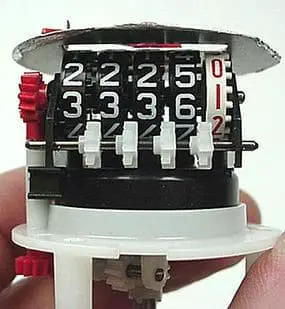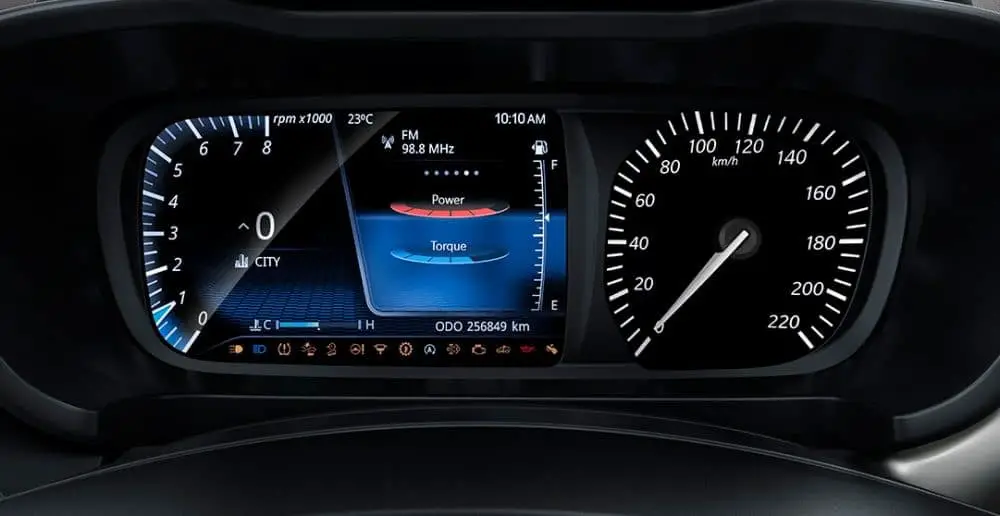You might have seen a meter on your dashboard that records the distances. This meter is known as an Odometer. It records the distance covered by your car in kilometers or miles, as per the standard used in your country.
Whenever you buy a car, the first thing you notice is the reading of an odometer. You try to buy a one with less reading. Now, the reading of an odometer can be tampered, intentionally. But in some cases, the reading changes due to alterations in the car.
Do you know, if someone replaces the original tires with larger or smaller tires, the reading of the odometer is disturbed? To understand how the bigger tires, affect the odometer, first, we need to understand what parameter does it uses to determine the distance covered by the car.
How does the Odometer determine the distance?
There are two types of Odometers, Mechanical and Electrical. To understand how each type determines the distance, we need to study their construction.
Mechanical Odometer:

Mechanical odometers are the oldest types of odometers used in automobiles. The first mechanical odometer was made centuries ago to measure distance. These odometers are common in motorbikes and bicycles. Some conventional cars still utilize these odometers. The mechanical odometer is turned by a flexible cable of a tightly wound spring. The cable is normally protected by a metal tube with a rubber casing.
In cars, one end of this cable is connected to the output shaft and the other is attached to the input shaft of the odometer. Since the transmission shaft utilizes gears running at quite higher rpm, the mechanical odometer has a series of worm gears to reduce the gear ratio. Simply speaking, if a gear ratio of 1690:1 is set by default, then after 1690 revolutions, the one digit of the odometer slides down mechanically.
Electrical Odometer:

Electrical odometers are the modern odometers used in present-day cars. They utilize different sensors and are controlled by Engine Control Unit (ECU). One of the sensors in this system, called the rpm sensor measures the number of revolutions, and sends information to ECU. Now, based on the given equation, the ECU multiplies circumference with a number of revolutions. The circumference is calculated based on the dimensions of diameter, set by the manufacturer. This is how the distance is calculated and displayed digitally on the screen.
Distance covered by Car = Circumference × No.of revolutions
= π×D×N
Does tire size affect odometer?
Since the distance measured by an odometer is directly proportional to the diameter of the installed tires, Then, it means that if you replace the original tires with the ones that have a larger or smaller diameter, the odometer reading is affected. It either shows less distance or more distance compared to the actual distance covered.
How do bigger tires affect Odometer?
So, our main query that how bigger tires affect the odometer is resolved. Since larger tires have more circumference, they cover more distance in a single revolution. So, it means that when you are using larger tires, the distance covered is more this time. You can also understand this in another way. If you take large footsteps, wouldn’t you reach the destination earlier? Since you have covered a larger distance in a single step.
The same is the case with larger tires, they cover more distance in one rotation. But since the odometer is calibrated to measure the distance based on the original tire size. So, even if tires are replaced it shows the reading based on its default setting. Hence, the reading you observe on the odometer is less as compared to the actual reading.
Similarly, if you replace the original tires with the small tires. Then, this time, a small distance is covered in one rotation of the tire since the circumference is reduced. But the odometer is set on default to measuring the distance based on the original tire dimensions. So, the odometer reading will be larger than the actual distance which the car has traveled.
How to calibrate an Odometer for bigger tires?
Now, one may ask if they have replaced their tires, can they calibrate their odometer based on the new tire dimensions. Since there are two types of odometers, mechanical and electrical, the calibration will be different for each type.
As mentioned earlier, the mechanical odometer has a cable and set of worm gears, set on some appropriate gear ratio. The gear ratio is set by default is based on the tire
19;s size. So, if you have to recalibrate this odometer, you need to determine the exact gear ratio and the number of gear teeth, based on the new tire size. This requires a lot of calculations and a layman cannot determine that. So, calibrating a mechanical odometer is quite difficult and is often not recommended.Electrical odometers, on the other hand, display information based on the programmed ECU. So, if the tires are replaced with bigger ones, then you just have to change the value of diameter in the programmed ECU. The ECU is attached to a computer, and a new input value of the diameter is fed into it. Obviously, you cannot do it yourself, you will need an expert technician.
What other devices are affected by bigger tires?
Apart from an odometer, the bigger tires also affect the reading of a speedometer since the speedometer also relies on the number of revolutions and diameter of the tires. So, if you are moving with bigger tires, the speedometer will show a speed which is less as compared to which you are moving. The smaller tires show more speed than the actual speed. Bigger tires improve the ground clearance, improve traction and performance. But these tires put a strain on the transmission system. So, if you install new tires, you have to modify the gear ratio of the transmission system to account for the changes.
I hope by now, you have got an idea of how bigger tires can affect the reading of the Odometer. And if you want to replace your tires, what necessary changes you would have to take into account for these new tires.

